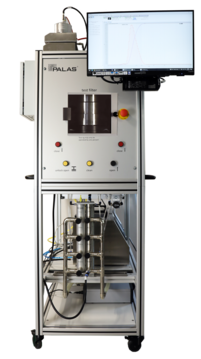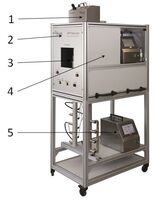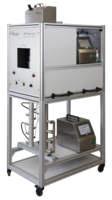MFP Nano plus 4000
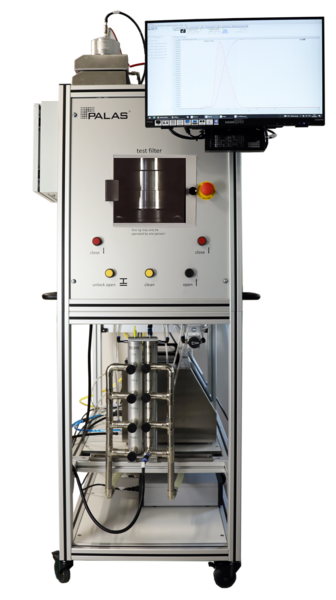
MFP filter test benches from Palas have already proven themselves many times over in practical use in development and quality control worldwide. The MFP Nano plus 4000 is specially designed to clearly determine the separation efficiency of HEPA and ULPA filter media in accordance with DIN EN 1822-3 and ISO 29463-3. The U-SMPS is a modern and powerful nanoparticle measuring device with a measuring range of 5 nm to 1 µm for particle size and quantity analysis. In the MFP Nano plus 4000, the separation efficiency at a specific size is measured simultaneously with one UF-CPC condensation core counter each in raw and clean gas.
Norms and certificates
National and international standards
EN 1822-3 ISO 29463-3
Operation principle
Simultaneous determination of the fractional separation efficiency with two UF-CPCs
The simultaneous measurement of the fractional efficiency in the MFP Nano plus 4000 offers the following special advantages:
- The real-simultaneous measurement of the particle concentration in raw and clean gas halves the measurement time when determining the fractional efficiency.
- The combination of two UF-CPC versions, the UF-CPC 200 for highest concentrations up to 2,000,000 particles/cm3 (single counting mode) in the raw gas and the UF-CPC 50 for highest counting rates at low concentrations in the clean gas corresponds to a dilution factor of 1:200. Conventional aerosol dilution can therefore be dispensed with for highly efficient filter media.
The universally applicable aerosol generator UGF 2000 can be used to generate aerosol distributions with DEHS or salt (NaCl / KCl) that are tailored to the MMPS range.
The extensive automation of the test sequence together with the clearly defined individual components and the individually adjustable sequence programs of the FTControl filter testing software ensure the high reliability of the measurement results.
The MFP filter test stand is a modular filter test system for flat filter media and small mini filters. Pressure loss curve, fractional separation efficiency or loading can be determined reliably and therefore economically within a very short time.
1. Variable aerosol generation with the UGF 2000 for KCl / NaCl or DEHS. Integrated Nafion drying section: The volume flow for aerosol generation is controlled individually via mass flow controller.
2. Aerosol neutralization: Soft X-ray Charger XRC 049 or corona discharge (optional)
3. Mobile pneumatic filter holder: This is used to quickly remove and load the test stand with integrated DEMC 2000 (Differential Electrical Mobility Classifier). The DEMC 2000 (Differential Electrical Mobility Classifier) contained in the U-SMPS pre-classifies the polydisperse aerosol generated with the UGF 2000 in terms of particle size. After the DEMC 2000, only monodisperse particles are contained in the test aerosol. The corresponding size is automatically regulated by the DEMC 2000 control unit.
4. Raw gas measurement of the number distribution with UF-CPC 200 for high concentrations: To measure the number of particles in the raw gas, the condensation core counter UF-CPC 200 is used for particle counting up to 2,000,000 particles/cm3 in single counting mode. This means that no dilution system is required for raw gas measurement in very high concentrations. There is no need for time-consuming cleaning of the systems.
5. Clean gas measurement of the number distribution with UF-CPC 50 for low concentrations: The “full flow” UF-CPC 50 is optimized for low particle concentrations (single counting mode up to 10,000 particles/cm3) in clean gas. With “full flow” particle counting in the UF-CPC, the entire sampling volume flow is fully analyzed. This means that very high counting rates are achieved in the clean gas at low particle concentrations.
The Palas filter testing software FTControl controls the U-SMPS and evaluates the data.
By selecting the appropriate solution concentration, the particle size distribution generated in the MFP Nano plus 4000 is adapted to the respective MPPS range.
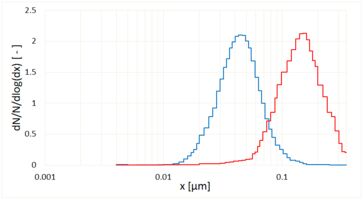
Abb. 1: Adaptation of the particle sizes to the required MPPS range with DEHS
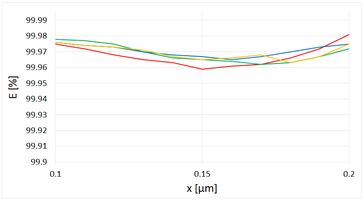
Abb. 2: Comparison of fractional separation efficiencies in the MPPS range at 140 nm
Automation:
The MFP Nano plus 4000 has built-in mass flow controllers for volume flow control, which can be automatically controlled via the FTControl filter testing software. The sensor data such as volume flow and differential pressure at the filter are automatically recorded during the filter test.
Proof of conformity of sampling in raw and clean gas:
Proof of compliance of the raw and clean gas measurement without a filter is demonstrated during the briefing.
With the MFP Nano plus 4000, fractional efficiency measurements in the MPPS range as well as over the entire measuring range are easily possible. In addition, the respective pressure loss of the medium is clearly determined at the respective flow velocity.
Benefits
Your special advantages
- Real-time determination of the fraction separation efficiency above 20 nm
- The measuring time for determining the fraction separation efficiency is halved by measuring the particle concentration in the raw and clean gas.
- No dilution necessary!
- Combining two UF-CPC versions, the UF-CPC for the highest concentrations, up to 2,000,000 particles/cm3 (single count mode) in the raw gas and the UF-CPC 50 for top counting rates at low concentrations in the clean gas, corresponds to a dilution factor of 1:200.
- Internationally comparable measurement results in accordance with DIN EN 1822-3 and ISO 29463-3
- Simple use of different test aerosols, such as NaCl / KCl or DEHS (others on request)
- Simple measurement of the fraction separation efficiency and determination of the MPPS range
- High reproducibility of the test method
- Flexible filter test software FTControl
- Easy to operate; even untrained personnel can be quickly trained in the use of the equipment
- Cleaning can be performed independently by the customer
- Short set-up times, fast throughput times
- Mobile set-up, easy to move on castors
- Clear verification of the function of the individual components and the system as a whole in the scope of pre-delivery acceptance testing and at delivery
- Reliable functioning
- Little maintenance required
- Reduces your operating expenses
Applications
Individual solutions for various industries
- Testing of filter media and small mini filters in product development and production monitoring
- Testing capability according to DIN EN 1822-3 (HEPA / ULPA) and ISO 29463-3
- Fractional efficiency measurement for other filter media in the range of approx. 20 nm to 1 μm
Technical features
In detail
- Aerosols
- Dusts (e.g., SAE dusts), salts (e.g., NaCl, KCl), liquid aerosols (e.g., DEHS)
- Test area of the medium
- 100 cm2
- Measurement range (size)
- U-SMPS: 10 – 800 nm
- Volume flow
- 0.48 – 5.76 m³/h - pressurized operation
- Power supply
- 115 – 230 V, 50/60 Hz
- Differential pressure measurement
- 0 – 2,500 Pa (others on request)
- Inflow velocity
- 1.3 – 16 cm/s (others on request)
- Compressed air supply
- 6 – 8 bar
- Dimensions
- Approx. 760 • 2,100 • 985 mm (H • W • D)
